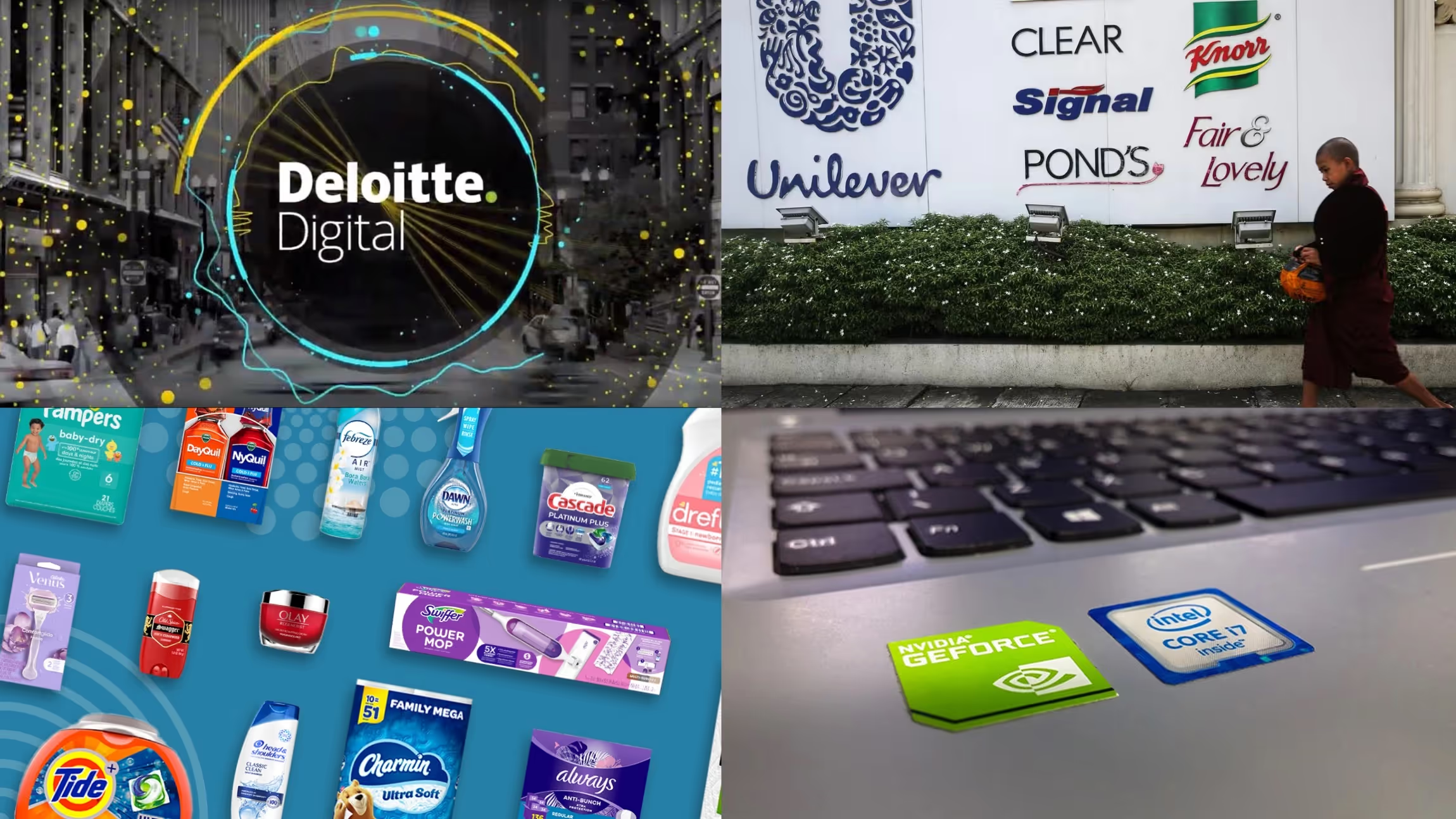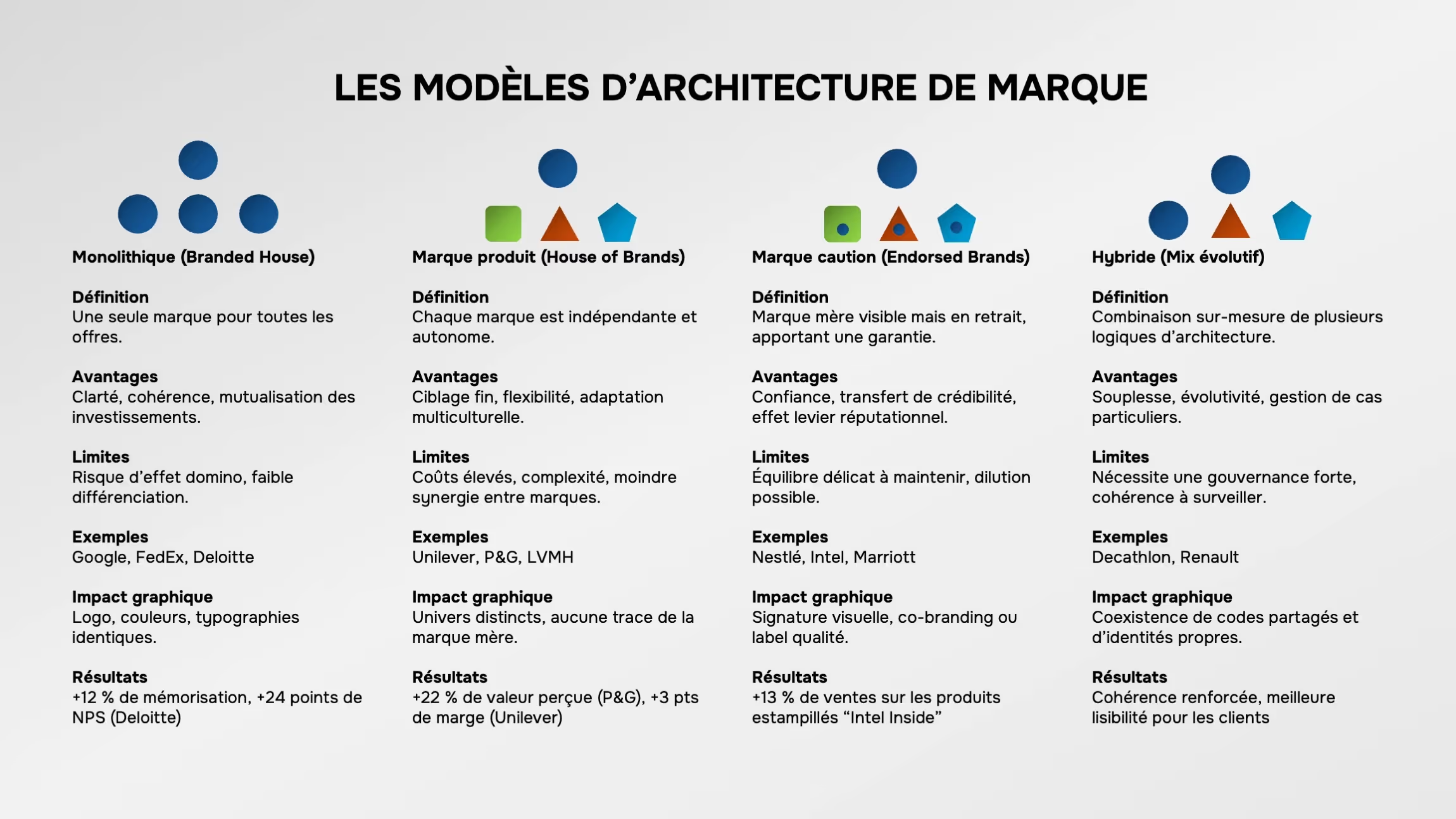1. It’s not about how you’re organized. It’s about how you want to be perceived.
Brand architecture is too often mistaken for an internal org chart or naming convention. In reality, it’s a perception tool — much more than a structural one. It answers one simple but essential question: How do you want your clients, partners, and talent to understand your offer?
Brand architecture is the system that shapes how your portfolio is read. It brings clarity, consistency, and meaning — or in some cases, intentional differentiation, as we’ll see in the examples below. It helps your company remain readable, credible, and desirable at every stage of growth.
What we want to show you here is that this isn’t a cosmetic exercise. It’s a strategic, visual, and cultural lever that can deeply transform your business performance. And most importantly: there’s no perfect model. Only choices to be made — depending on your strategy, your audiences, and your ambitions.
2. The Major Brand Architecture Models
Monolithic Brand (or Branded House)

Examples: Google, FedEx, Accenture, DHL
This model focuses on the power of a single name. All services or products fall under one unified brand. Visually, it’s a promise of consistency. Strategically, it’s a bet on centralized image control.
- Best for: trust-driven, mastery-focused, or consistent-value companies
- Watch out: a crisis in one product can affect the entire brand
📈 FedEx, by segmenting into FedEx Express, FedEx Ground, etc., boosted brand recall by +12% compared to fragmented competitors (Interbrand, 2023).
Product Brands (or House of Brands)

Examples: P&G, Unilever, LVMH, General Motors
Each brand lives its own life. This is the model for companies with diverse portfolios, where each product needs its own tone, design, and audience.
- Best for: covering multiple segments, cultures, or consumer bases
- Watch out: increased complexity and higher marketing investment
📈 In 2022, this model helped P&G achieve a 22% quality perception premium for its leading brands vs. private labels.
Endorsed Brands
Examples: Nestlé, Intel, Nespresso by Nestlé, Courtyard by Marriott
The parent brand supports, reassures, and endorses — without overwhelming. This model plays on the balance between the independence of sub-brands and the credibility of the parent.
- Best for: launching new offers while leveraging your reputation
- Watch out: finding the right balance can be tricky
📈 The Intel Inside campaign increased sales of partner PCs by +13% (Harvard Business Review, 2021).
3. Brand Architecture as a Global Performance Lever

Far from a theoretical exercise, brand architecture is a true growth driver. It acts as a performance multiplier on several levels:
1. Better Clarity = Higher Customer Conversion
A clear brand portfolio helps customers, distributors, and talent better understand your value proposition. When each offer naturally fits into the ecosystem, the experience feels smoother.
🎯 Deloitte successfully consolidated its brand system. Where different entities (Deloitte Digital, Deloitte Consulting, etc.) used to coexist, everything was unified under one banner — resulting in a +24-point NPS gain within 18 months.
2. Marketing Efficiency = Better ROI or Sharper Targeting
Choosing an architecture enables smarter marketing spend — either through shared investment (monolithic model) or segmented targeting (multi-brand model).
🎯 Unilever, by cutting 60 sub-brands between 2020 and 2022, focused its budget on top performers. This portfolio simplification brought +3 points of gross margin and reinforced its flagship brands (like Dove or Persil).
3. Portfolio Management = Smarter Strategic Decisions
A clear architecture helps identify which brands to grow, reposition, or retire. It’s a strategic tool for both marketing and leadership teams.
🎯 P&G operates each brand (Gillette, Ariel, Pampers…) independently, allowing granular tracking and tailored innovation or communication decisions — yielding a +22% perceived value premium over private labels.
4. Value Creation = Stronger Long-Term Valuation
Brand architecture builds consistent intangible capital. This boosts valuation in cases of fundraising, acquisition, or repositioning.
🎯 Intel’s “Intel Inside” endorsement didn’t just increase partner product sales by +13% — it cemented Intel’s own brand as a B2B quality benchmark.
4. What Does It Look Like Visually?
Brand architecture is reflected in visual endorsement systems:
A. Strong System (Monolithic)
Visual and verbal endorsement is dominant
Ex: Google, FedEx
➡ The parent brand is omnipresent: logo, typeface, color, and visual codes are unified.
B. Moderate System (Explicit Endorsement)
Visual and/or verbal endorsement is visible but secondary
Ex: Nespresso by Nestlé, Kellogg’s Special K
➡ The parent brand is present but discreet — small typography, signature or label.
C. Weak System (House of Brands)
Visual identity is entirely independent
Ex: Axe, Dove, Persil (Unilever)
➡ No visual mention of the parent company. Each brand has its own identity.
D. Hybrid Systems
Ex: Decathlon and its passion brands (Kalenji, Tribord, Quechua…)
➡ Originally separate product brands, now evolving toward visual consistency through co-branding (like the recent “D” symbol from Decathlon).
And You — What Perception Do You Want to Build?
This isn’t just about logos. It’s not a cosmetic choice. It’s a strategic one — one that makes your offer clearer, your brand stronger, and your company more legible, both internally and externally.
Ask yourself:
- Are you launching a new offer and unsure how it fits into your portfolio?
- Is your parent brand overshadowing your products — or holding them back?
- Have you recently acquired or merged with another company and need to rebuild the narrative?
- Do your clients no longer fully understand who you are and what you offer?
At ELEF, we help businesses structure or transform their brand architecture to support their growth, clarity, and impact.
This might not just be a design topic.
It might just be the strategic lever you’ve been waiting for.



